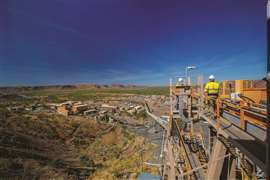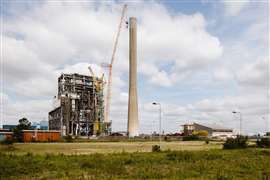Clean power - Richard High reports from Chile's 158 MW La Confluencia HEP
07 December 2009

With low fossil fuel reserves and an increasing reliance on imported natural gas the Chilean government is expanding its hydro-electric power (HEP) generating capabilities.
One of the largest projects currently under construction is the US$ 350 million, 158 MW La Confluencia. Richard High reports.
Once you leave the comfort of Chile's national highway system behind getting to the run-of-river La Confluencia HEP is a bone shaking experience for man and machine.
One that can leave you gasping in awe at the majesty of the snow capped Andes that surround you and the vertiginous drop just inches beyond the increasingly dusty car window.
Located in the pristine Tinguiririca Valley in the Andes, La Confluencia is 1430 m above sea level (asl) and 150 km south of the capital Santiago.
La Confluencia will draw its water from three rivers - the Tinguiririca, Portillo and Azufre, which in turn are fed by rainwater, melting snow and glacial ice.
Keeping this wilderness in a pristine state is a high priority for the Chilean government, the project's owners Tinguiririca Energia and the Constructora Hochtief-Tecsa (CHT) joint venture delivering the project.
Tinguiririca Energia has also set up the Tinguiririca Participa initiative, which has already funded nearly 100 community projects in environmental protection, health and education.
The site itself is run to the ISO 14000 environmental management standard and there are also other measures imposed by CHT to ensure its work and workforce leave the valley as close to its original state as possible.
"No structure on the site will be higher than 15 m," said Axel Paul, general manager for CHT, "which will reduce the visual impact of the project once it's complete.
"No one was displaced and as La Confluencia is a run-of-river project there is very little impact on the environment - no huge lake, for example. In fact when the project is complete all that will be visible is the reservoir and power house," he added.
"The impact to the environment is during construction, with the movement of men, machines and material. But we have worked very hard to minimise this, and there are strict controls governing travel speeds and oil spills," added Mr Paul.
Tunnels and spillways
La Confluencia is being developed by Tinguiririca Energia, which consists of Australian renewable energy company Pacific Hydro and Norway's SN Power.
It is designed to work at full capacity from November to March and will supply 120000 people with power.
Hochtief and Tecsa started work in October 2007 on a 70:30 basis providing engineering, procurement and construction.
This includes the design and construction of a powerhouse, installation of two Francis-type Turbines, and some 22 km of tunnels and two river diversions.
La Confluencia consists of two main intakes, five secondary intakes with a desander and conveyance systems that divert river water to the surface powerhouse.
It is situated upstream of another HEP project, La Higuera, which is also being developed by the Tinguiririca Energia.
The two are designed to operate in cascade, with a combined generating capacity of about 1400 GWh per year. However, they can also operate independently should it be necessary to close either for repairs and maintenance.
The Portillo branch comprises a low weir and spillway on the Portillo River at 1465 m asl. Water will pass through a desander and a short open channel before entering a 12 km-long low-pressure tunnel that runs to a surge chamber above the powerhouse at the confluence of the Azufre and Tinguiririca rivers.
The Tinguiririca branch consists of a low diversion weir and spillway across the Tinguiririca River at 1460 m asl. This will divert partial flows through a desander and a short open channel to a 1.2 million m3 storage reservoir.
From there the water will travel through a 9.3 km-long, 35 m2 low-pressure tunnel that joins the surge chamber above the powerhouse.
Both the Tinguiririca and Portillo branch tunnels will terminate at a 250 m-high, 4.2 m diameter concrete lined vertical shaft that continues with a high pressure tunnel, which is concrete lined before narrowing to a steel lined, 350 m-long, 3.1 m-diameter tunnel that delivers the water to the open-air powerhouse at high pressure.
With a total tunnel length of 21.92 km, over 747000 m3 of material will be excavated, while another 121000 m3 of material will be excavated on the surface.
Mr Paul estimates that over 140000 m3 of concrete/shotcrete and 5.5 tonnes of reinforced steel will be needed to complete the project.
A special feature of the project is the ability to fill the reservoir on the Tinguiririca side with water from the Portillo side.
"This is because the Portillo tunnel feeds into the pressure shaft at a higher height than the intake from the Tinguiririca reservoir," explained Mr Paul. "I think this is one of the most interesting aspects technically, and the one I find the most exciting."
Drilling rights
As the Andes are characterised by uplifted sedimentary, volcanic and intrusive rock of a highly variable nature, it has not been possible to predict with any degree of certainty what rock conditions would be encountered.
This has meant relatively slow progress, although at the time of KHL.com's visit the project was about 70% complete, well ahead of schedule.
Drilling started with stabilising the rock around the powerhouse, said Otto Krahan, CHT's plant and equipment manager.
Three Sandvik DC301R drilling rigs, which arrived on site in September 2008, were used to drill 3.5 m-deep, 38 and 64 mm diameter holes with Sandvik R32 bits.
Stabilisation was complete by the time the six Sandvik DT 720C jumbos began drilling on a combined total of 12 fronts in the tunnels and surge chamber.
They are fitted with two drilling booms capable of drilling across a 70 m2 cross section (7 m-high by 11 m-wide), while the third is used as an inspection cage to increase progress on the job.
They are mainly equipped with 45 mm diameter Sandvik R32 drilling tools fitted with nine-button RT300 bits, which are sharpened on site by one of the 16 Sandvik technicians.
Sandvik has two containers on site for storage and admin, with an additional project supervisor - Felix Olguin - and one admin person.
The technicians work one of three eight hour shifts, with 10 days on, three days off.
There are two blasts on each front per day, if the rock conditions allow, and in each of the two main tunnels the DC300 rigs follow the DT 720Cs carrying out rock bolting, of which there are five types.
Once this is complete the tunnels walls are shotcreted, although Mr Paul said CHT tried to avoid this where possible.
"Like any other partnership our working relationship is based on trust," said Mr Olguin. "CHT trusts us to deliver our products when they are needed and we trust them to continue the relationship on other projects."
And so far, added Mr Paul, the relationship is working well. "We've been very pleased with the availability of the rigs, which is well above 95%. Of course there are the usual stoppages on a job of this size, but I've been surprised at how easily the rigs are handling the workload," he added.
Challenges
While the rigs may be working beyond expectations there are still challenges in completing a project of this size in such a difficult location, said Mr Paul.
"With 1800 people working on site, including five families, access, the climate, logistics, the tunnels, the geology and of course water all present challenges. Most supplies come in by road, but helicopters have been used," said Mr Paul.
The hard winter that engulfed the region 18 months ago also had an effect on progress. "We ended up behind schedule, with many of the access roads into and around the site washed away following unusually heavy rains and flash floods. But it didn't take us long to get back on track," he added.
A shorter version of this site report appeared in International Construction magazine. To subscribe to International Construction click here.
STAY CONNECTED


Receive the information you need when you need it through our world-leading magazines, newsletters and daily briefings.
CONNECT WITH THE TEAM










